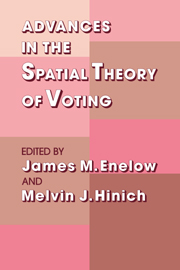Book contents
- Frontmatter
- Contents
- Foreword
- ADVANCES IN THE SPATIAL THEORY OF VOTING
- 1 Introduction
- 2 Multiparty Competition, Entry, and Entry Deterrence in Spatial Models of Elections
- 3 Heresthetic and Rhetoric in the Spatial Model
- 4 Spatial Strategies When Candidates Have Policy Preferences
- 5 A Decade of Experimental Research on Spatial Models of Elections and Committees
- 6 Candidate Uncertainty and Electoral Equilibria
- 7 The Theory of Predictive Mappings
- 8 Multicandidate Spatial Competition
- 9 The Setter Model
- Author Index
- Subject Index
9 - The Setter Model
Published online by Cambridge University Press: 05 March 2012
- Frontmatter
- Contents
- Foreword
- ADVANCES IN THE SPATIAL THEORY OF VOTING
- 1 Introduction
- 2 Multiparty Competition, Entry, and Entry Deterrence in Spatial Models of Elections
- 3 Heresthetic and Rhetoric in the Spatial Model
- 4 Spatial Strategies When Candidates Have Policy Preferences
- 5 A Decade of Experimental Research on Spatial Models of Elections and Committees
- 6 Candidate Uncertainty and Electoral Equilibria
- 7 The Theory of Predictive Mappings
- 8 Multicandidate Spatial Competition
- 9 The Setter Model
- Author Index
- Subject Index
Summary
Political processes that involve voting are invariably subject to an element of agenda control. Predictions about the outcomes of these processes can be made only if we specify (a) the preferences of the agenda setters, (b) the preferences of the voters, (c) institutional constraints on the process—the rules of the game, (d) the behavioral rules used by voters (are they sincere-myopic or sophisticated—forward looking), and (e) the information structure of the game.
What has come to be known as the monopoly model or setter model (Romer and Rosenthal 1978, 1979a) puts enormous, restrictive structure on the political process. In this essay, I limit the discussion to this model and its extensions. The first part of the essay analyzes the case of a single issue (a budget) under complete (and perfect) information. Dynamic as well as static analysis is covered. The second part treats effects of both simple uncertainty and strategic uncertainty that allows for learning. The third part summarizes empirical evidence that bears on the model. The essay contains some new work on the dynamics of agenda setting with sophisticated voters in a complete information environment and on learning by agenda setters under incomplete information; the basic thrust, however, is directed at providing a review.
THE SETTER MODEL WITH COMPLETE INFORMATION
The setter model was developed in the context of budgeting decisions. Motivated by Niskanen (1971), Romer and Rosenthal made several simplifying assumptions. First, the agenda setter was assumed to be an individual whose goal is to maximize the total budget. Second, voter preferences were single-peaked over budget levels. Single-peaked preferences for three voters are illustrated in Figure 9.1. The top of a voter's curve represents the voter's ideal point.
- Type
- Chapter
- Information
- Advances in the Spatial Theory of Voting , pp. 199 - 234Publisher: Cambridge University PressPrint publication year: 1990
- 21
- Cited by



